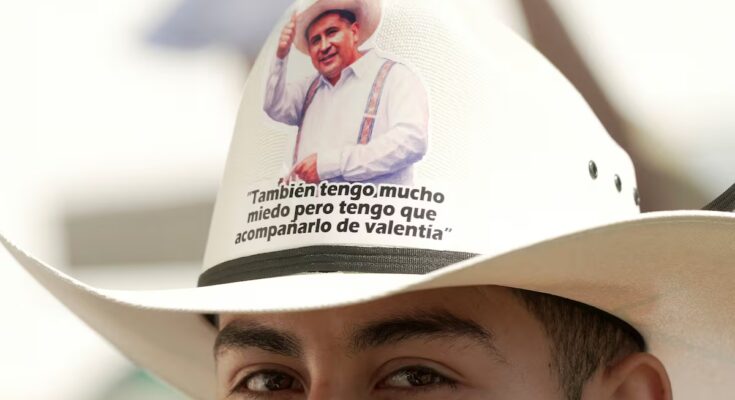The hat has become the symbol of resistance to the harshness of violence in Mexico. It is also the legacy of Carlos Manzo in Uruapan, Michoacán, after he was shot dead in the town square during the Day of the Dead festivities. That same hat, a backpack crossed on the chest and modest clothes, typical attire in many rural regions of the country, distinguished Manzo during his time in the Mexican Congress (2021-2024) before becoming mayor and losing his life in that position. When the Michoacan spoke as a congressman, his hat rested on the dais, which made it easier to identify him when Morena’s majority bench was still a compendium of new faces, including his own. The end of that legislature marked the end of his brief relationship with the party in power and the birth, in the same year, of his political project made up of local leaders without a party: the Hat Movement.
The name he gave to the political gamble electorally running as independent, in reference to his characteristic accessory, then symbolized the people, the working class of the countryside, and now brings together many critics of the insecurity situation, who have raised their voices or joined the wave of opposition, taking advantage of the effervescent indignation left by Manzo’s murder at the hands of organized crime.
In 2024, the Hat Movement has managed to sneak onto the political map, gaining space at all levels. Manzo, with 95,000 votes, became the first municipal president of Uruapan to reach that position without a party. His current, also known as La Sombreriza, obtained three deputies from Morena, the second best positioned: two local, with Carlos Bautista Tafolla and Conrado Paz, and one federal with Guadalupe Mendoza. Everything for Michoacán. A remarkable take-off for such a young group.
Now he has made a decisive leap to the forefront of Mexican politics. The assassination of Manzo and the crisis of violence in that and other regions of the country have, for the moment, catapulted his political group to the point that the polling stations see in it the possibility of fighting for power from the governing party, at least in Michoacán, one of the states most affected by the fist of organized crime. Although the duration of the hat’s effect is still uncertain and, before any risky predictions, Manzo’s political heirs will have to sustain themselves beyond this cyclical phase.
Political analyst Salvador Camarena believes it is prudent not to overdo it. “A movement requires several acid tests of what it wants and what its agenda is,” he argues. Less than a month has passed since the mayor’s murder, spirits remain high and forecasts on the extent of La Sombreriza are uncertain. “I don’t downplay the legitimacy of their demands or the fact that they come from a region of the country and have shaken the centralism of an egocentric federal government, but it is too early to assume that a movement has arrived that will become a reference in the medium or long term,” he underlines, suggesting that it is a strictly cyclical effect.
Morena, Mexico’s most powerful party founded by former president Andrés Manuel López Obrador, had a long and bumpy road before winning the presidential election. Its registration as a national political group in 2014 was preceded by almost a decade of campaigns, tours across the country, rallies without a quorum, sit-ins in the Zócalo and on the busiest streets of Mexico City. He went through three presidential campaigns before reaching the seat of power. A murder and collective indignation were enough for this other movement, that of the hat, to advance by 41 points in the electoral preference – the percentage with which the governor of Michoacán, Alfredo Ramírez Bedolla, won in 2021 -, according to local polls. The members of the movement supported by Manzo suffered the political effect caused by the mayor’s assassination. “Say goodbye to the luxuries of power, to the misdeeds and to the corruption that clearly shines through, because now it’s up to us, those of the Cappello Movement”, launched Guadalupe Mendoza against the government party from the gallery of the Chamber of Deputies.
A few days ago, at the entrance to the Michoacán Congress, a harangue rang out. “Pura sombreriza!, Pura sombreriza!, Pura sombreriza!”, dozens of excited people waved their hats in their hands. Parallel to the protest, Grecia Quiroz, Manzo’s widow, embracing her husband’s hat, received the government that cost the life of the father of her two children. “They have not silenced this hat movement and they will not silence it,” she began, flanked by deputies dressed in the accessory, in front of a legislature with a pro-government majority. The day before, hats and bloody candles covered the opposition seats in the Chamber of Deputies during the discussion of the Sheinbaum government’s budget for next year.
“Those who ordered the killing of Carlos Manzo did not know that this hat has an unstoppable and tireless force with which in 2027 we will give them a vote of punishment because we will assert ourselves and honor the memory of Manzo,” Quiroz said again over the weekend during a day of protests in Uruapan, former interim president of the municipality. The political message in a state governed by morenoism was direct. The tragedy of Uruapan marked a turning point in Mexican politics. Manzo’s widow outlined her goals. “I will follow in the footsteps of Carlos Manzo, I will leave you an Uruapan, a Michoacán and a Mexico that he would have wanted,” he said at his inauguration.
The hat movement faces its first test this weekend. The call for a mass march in Mexico City, in memory of the mayor of Uruapan and against violence. Grecia Quiroz, stood out. “We are not the ones leading this march,” he said Thursday after meeting with Security Secretary Omar García Harfuch. The mobilization will converge with that of Generation Z, which was discredited by Sheinbaum as an international disinformation campaign. Before the dismissal of the municipal president of Uruapan, members of La Sombreriza called for a peaceful demonstration. “This march should be the symbol of a Mexico that demands justice, that is tired of the circuses of power, false embraces and empty promises,” said Carlos Bautista. The mobilization will test the strength The Hat Movement has gained, while the political times will determine whether it is here to stay or not.



